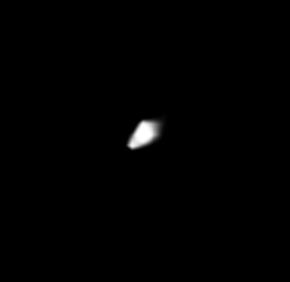 | |
| Discovery | |
|---|---|
| Discovered by | Mark R. Showalter and Jack J. Lissauer |
| Discovery date | August 25, 2003 |
| Designations | |
| Designation | Uranus XXVI |
| Pronunciation | /ˈmæb/ |
| Adjectives | Mabian |
| Orbital characteristics | |
| Semi-major axis | 97 736 km |
| Eccentricity | 0.00347 |
| Orbital period (sidereal) | 0.923 d |
| Average orbital speed | 7.70 km/s (calculated) |
| Inclination | 0.12217° (to Uranus' equator) |
| Satellite of | Uranus |
| Physical characteristics | |
| Mean radius | 6 km/12.4±0.5 km |
| Surface area | ~450/1930 km |
| Volume | ~900/7990 km |
| Mass | ~(0.90/8.0)×10 kg |
| Mean density | 0.5–1.2 g/cm 1 g/cm (assumed) |
| Surface gravity | ~0.002/0.003 m/s |
| Escape velocity | ~0.004/0.009 km/s |
| Synodic rotation period | synchronous |
| Axial tilt | 0 |
| Albedo | ~0.46/0.1 (assumed) |
| Temperature | ~63 K |
| Apparent magnitude | 26 |
Mab, or Uranus XXVI, is an inner satellite of Uranus. It was discovered by Mark R. Showalter and Jack J. Lissauer in 2003 using the Hubble Space Telescope. It was named after Queen Mab, a fairy queen from English folklore who is mentioned in William Shakespeare's play Romeo and Juliet.
Because the moon is small and dark, it was not seen in the heavily scrutinized images taken by Voyager 2 during its Uranus flyby in 1986. However, it is brighter than another moon, Perdita, which was discovered from Voyager's photos in 1997. This led scientists to re-examine the old photos again, and the satellite was finally found in the images. Following its discovery, Mab was given the temporary designation S/2003 U 1.
The size of Mab is not precisely known. If it is as dark as Puck, it is about 24.8±1.0 km in diameter. On the other hand, if it has a relatively bright surface like the neighbouring moon Miranda, it would be smaller than Cupid and comparable to the smallest outer satellites. Infrared observation published in 2023 suggest that Mab is probably a 12-km body with a Miranda-like surface, rich in water ice; though not leaving out the possibility of it being a 24-km body with a Puck-like surface.
Mab is heavily perturbed. The actual source for perturbation is still unclear, but is presumed to be one or more of the nearby orbiting moons.
Mab orbits at the same distance from Uranus as the μ ring (formerly known as R/2003 U 1), a dusty ring discovered around the same time as Mab. The moon is nearly the optimal size for dust production, since larger moons can recollect the escaping dust and smaller moons have too small surface areas for supplying the ring via ring particle or meteoroid collisions. No rings associated with Perdita and Cupid have been found, probably because Belinda limits the lifetimes of dust they generate.
See also
References
- "Mab". Dictionary.com Unabridged (Online). n.d.
- Richard Allen Isomaki (1986) Shelley's Causal Themes. PhD thesis, University of Washington.
- Ćuk, Matija; French, Robert S.; Showalter, Mark R.; Tiscareno, Matthew S.; El Moutamid, Maryame (2022). "Cupid is not Doomed Yet: On the Stability of the Inner Moons of Uranus". The Astronomical Journal. 164 (2): 38. arXiv:2205.14272. Bibcode:2022AJ....164...38C. doi:10.3847/1538-3881/ac745d.
- French, Robert S.; Showalter, Mark R. (August 2012). "Cupid is Doomed: An Analysis of the Stability of the Inner Uranian Satellites". Icarus. 220 (2): 911–921. arXiv:1408.2543. Bibcode:2012Icar..220..911F. doi:10.1016/j.icarus.2012.06.031.
- ^ Molter, Edward M.; De Pater, Imke; Moeckel, Chris (2023). "Keck near-infrared detections of Mab and Perdita". Icarus. 405: 115697. arXiv:2307.13773. Bibcode:2023Icar..40515697M. doi:10.1016/j.icarus.2023.115697. S2CID 259885759.
- Sheppard, Scott S. "Uranus' Known Satellites". Carnegie Institution (Department of Terrestrial Magnetism). Archived from the original on 2013-10-15. Retrieved 2011-11-02.
- ^ "Planet and Satellite Names and Discoverers". Gazetteer of Planetary Nomenclature. USGS Astrogeology. July 21, 2006. Retrieved 6 August 2006.
- ^ Showalter, Mark R.; Lissauer, Jack J. (September 25, 2003). "S/2003 U 1 and S/2003 U 2". IAU Circular. 8209: 1. Bibcode:2003IAUC.8209....1S. ISSN 0081-0304. Retrieved 2011-11-02.
- ^ Showalter, Mark R.; Lissauer, Jack J. (2006-02-17). "The Second Ring-Moon System of Uranus: Discovery and Dynamics". Science. 311 (5763): 973–977. Bibcode:2006Sci...311..973S. doi:10.1126/science.1122882. PMID 16373533. S2CID 13240973.
- Ćuk, Matija; French, Robert S.; Showalter, Mark R.; Tiscareno, Matthew S.; Moutamid, Maryame El (2022-07-16). "Cupid is not Doomed Yet: On the Stability of the Inner Moons of Uranus". The Astronomical Journal. 164 (2): 38. arXiv:2205.14272. Bibcode:2022AJ....164...38C. doi:10.3847/1538-3881/ac745d. ISSN 1538-3881.
- Showalter & Lissauer (2006), as cited in Ćuk et al. (2022).
- Layton, Laura (December 28, 2005). "Uranus' second ring-moon system". Astronomy.com. Astronomy Magazine. Archived from the original on March 31, 2012. Retrieved 2014-11-22.
External links
- Hubble Uncovers Smallest Moons Yet Seen Around Uranus – Hubble Space Telescope news release (25 September 2003)
- NASA's Hubble Discovers New Rings and Moons Around Uranus – Hubble Space Telescope news release (22 December 2005)
- Hubble detects two large outer rings, two new moons orbiting Uranus (Courtesy of Astronomy Magazine 2005)
| Uranus | |||||||
|---|---|---|---|---|---|---|---|
| Geography | |||||||
| Major moons | |||||||
| Astronomy |
| ||||||
| Exploration |
| ||||||
| Related | |||||||
| Moons of Uranus | |||||
|---|---|---|---|---|---|
| |||||
| Inner | |||||
| Major (spheroid) | |||||
| Outer (irregular) |
| ||||
| Geological features | |||||
| Natural satellites of the Solar System | ||
|---|---|---|
| Planetary satellites of |   | |
| Dwarf planet satellites of | ||
| Minor-planet moons | ||
| Ranked by size | ||